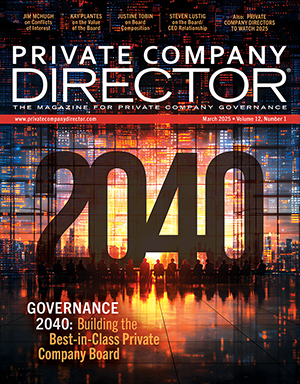In today’s complex and often polarized business climate, fostering a culture of belonging remains both a competitive advantage and a moral imperative. However, the terminology and approaches historically associated with DEI are being challenged in ways that require corporate leaders, especially board directors, to rethink how they engage with these topics.
This checklist is designed to help private boards initiate meaningful, values-driven conversations about inclusive influence without relying on politicized language or performative gestures. Each question is crafted to guide directors in aligning inclusive practices with strategic outcomes, such as innovation, talent excellence and long-term sustainability.
By shifting from compliance to curiosity, from labels to leadership, your board can continue doing the work of belonging in a thoughtful, authentic and effective manner.
Aligning Inclusion with Business Strategy
- How do our current business values support inclusive leadership?
- Are we clearly connecting inclusive practices to innovation, talent development and long-term growth?
- What examples from our organization show how inclusive decision-making has benefited our bottom line?
Reframing Language and Approach
- In what ways can we reframe our messaging around inclusion to reflect our values?
- Are we using language that resonates with stakeholders across backgrounds and perspectives?
- How are we distinguishing between regulatory compliance and cultural commitment?
Practicing Inclusion in Governance
- How inclusive are our board and executive team interactions?
- Do our discussions reflect diversity of thought, background and lived experiences?
- Are we modeling inclusive behaviors in decision-making and engagement?
Elevating Curiosity and Cultural Competence
- Are we encouraging curiosity about different perspectives and experiences?
- What opportunities exist for board members to develop cultural intelligence?
- What lessons have we learned from past instances of unintentional exclusion?
Operationalizing Inclusion Without Overreach
- Which business operations already reflect inclusive values?
- How can we reinforce inclusion in hiring, succession planning and team dynamics?
- Are we analyzing data that reveals our internal culture and belonging practices?
Moving from Performative to Strategic
- What are we doing because we believe in it — not just to check a box?
- Are we sharing stories of inclusive leadership driving measurable outcomes?
- Are we sunsetting symbolic gestures in favor of strategic, sustainable initiatives?
Navigating Change Confidently
- How are we preparing to lead through cultural complexity and organizational change?
- What does inclusive influence look like during uncertainty?
- What’s our message about the “why” behind our inclusive efforts?
Sustaining Progress Amid Political Headwinds
- How can we protect inclusive practices from political and social volatility?
- Who is responsible for maintaining inclusive influence as a strategic priority?
- Are our values embedded in continuity, succession and risk management plans?
Next Steps: Reflect and Revisit
Inclusive leadership is not a one-time initiative; it’s an ongoing mindset that shapes every decision, policy and relationship within your organization. As a board, your influence sets the tone for how inclusion is modeled and measured at every level of the business.
Here’s how to turn these conversations into action:
- Schedule time for regular review. Revisit this checklist quarterly to assess progress, revisit unanswered questions and update your approach based on what you’ve learned.
- Engage your executive team. Use these questions as a basis for dialogue between the board and C-suite leaders to ensure alignment across governance and operations.
- Identify metrics that matter. Move beyond performative metrics and identify leading indicators of belonging that reflect your unique organizational values.
- Make inclusion part of strategic risk management. Consider how inclusive influence contributes to long-term resilience, stakeholder trust and business continuity.
Remember: Belonging is not a brand. It’s a lived experience, shaped by intentional leaders like you.



